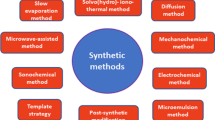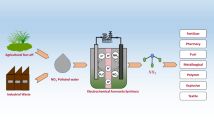Abstract
In this work, removal of antipyrine was studied through two-dimensional (2D) and three-dimensional (3D) electrolysis. 2D electrolysis was firstly studied with the Ti/SnO2-Ta2O5-IrO2 anode as working electrode. Operating parameters affecting antipyrine removal, such as current density, electrode distance, and initial concentration of antipyrine, were investigated and optimized. As the limited antipyrine removal efficiency of 48.0% was not satisfying, 3D electrolysis with γ-Al2O3 as particle electrodes was introduced in the purpose of improving the antipyrine removal. An obviously enhanced removal efficiency of 78.3% was obtained, which seemingly validated the effect of particle electrodes in improving antipyrine removal. Hence, an effort to further enhance the antipyrine removal efficiency was made through improving the electrochemical characteristics of γ-Al2O3 as particle electrodes. Modified Sn-Sb-Bi/γ-Al2O3 particles were thus prepared through impregnation method. And a desirable antipyrine removal efficiency of 94.4% and energy consumption of 0.18 kWh/g antipyrine were achieved in the 3D electrolysis with Sn-Sb-Bi/γ-Al2O3 as particle electrodes. Furthermore, possible mechanism and pathway of antipyrine degradation in 3D electrolysis were explored through detection of ·OH using terephthalic acid fluorescent probe method and detection of antipyrine degradation intermediates using LC-MS.








Similar content being viewed by others
References
Bilińska L, Gmurek M, Ledakowicz S (2016) Comparison between industrial and simulated textile wastewater treatment by AOPs–biodegradability, toxicity and cost assessment. Chemical Engineering Journal 306:550–559
Brodin T, Fick J, Jonsson M, Klaminder J (2013) Dilute concentrations of a psychiatric drug alter behavior of fish from natural populations. Science 339:814–815. https://doi.org/10.1126/science.1226850
Bruguera-Casamada C, Sirés I, Brillas E, Araujo RM (2017) Effect of electrogenerated hydroxyl radicals, active chlorine and organic matter on the electrochemical inactivation of Pseudomonas aeruginosa using BDD and dimensionally stable anodes. Separation and Purification Technology 178:224–231
Cotillas S, Clematis D, Cañizares P, Carpanese MP, Rodrigo MA, Panizza M (2018a) Degradation of dye Procion Red MX-5B by electrolytic and electro-irradiated technologies using diamond electrodes. Chemosphere 199:445–452
Cotillas S, Lacasa E, Sáez C, Cañizares P, Rodrigo MA (2018b) Disinfection of urine by conductive-diamond electrochemical oxidation. Applied Catalysis B: Environmental 229:63–70
García-Espinoza JD, Nacheva PM (2019) Effect of electrolytes on the simultaneous electrochemical oxidation of sulfamethoxazole, propranolol and carbamazepine: behaviors, by-products and acute toxicity. Environ Sci Pollut Res 26:6855–6867
Inyinbor AA, Bello OS, Fadiji AE, Inyinbor HE (2018) Threats from antibiotics: a serious environmental concern. J Environ Chem Eng 6:784–793
Ji J, Li X-y XJ, Yang X-y, H-s M, Z-r Y (2018) Zn-Fe-rich granular sludge carbon (GSC) for enhanced electrocatalytic removal of bisphenol A (BPA) and Rhodamine B (RhB) in a continuous-flow three-dimensional electrode reactor (3DER). Electrochim Acta 284:587–596
Lin H, Niu J, Xu J, Li Y, Pan Y (2013) Electrochemical mineralization of sulfamethoxazole by Ti/SnO2-Sb/Ce-PbO2 anode: kinetics, reaction pathways, and energy cost evolution. Electrochim Acta 97:167–174. https://doi.org/10.1016/j.electacta.2013.03.019
Liu W, Ai Z, Zhang L (2012) Design of a neutral three-dimensional electro-Fenton system with foam nickel as particle electrodes for wastewater treatment. Journal of Hazardous Materials 243:257–264. https://doi.org/10.1016/j.jhazmat.2012.10.024
Liu P, Yu X, Zhao Q, Cui Y, Li Y, Lu J, Hou B (2018a) Influence of EfOM on simultaneous rejection and degradation of PhACs during a forward osmosis coupled with electrochemical oxidation process. Chemical Engineering Journal 352:899–908
Liu S, Wang Z, Li J, Zhao C, He X, Yang G (2018b) Fabrication of slag particle three-dimensional electrode system for methylene blue degradation: characterization, performance and mechanism study. Chemosphere 213:377–383. https://doi.org/10.1016/j.chemosphere.2018.09.077
Loos G, Scheers T, van Eyck K, van Schepdael A, Adams E, van der Bruggen B, Cabooter D, Dewil R (2018) Electrochemical oxidation of key pharmaceuticals using a boron doped diamond electrode. Separation and Purification Technology 195:184–191
Moreira FC, Boaventura RA, Brillas E, Vilar VJ (2017) Electrochemical advanced oxidation processes: a review on their application to synthetic and real wastewaters. Appl Catal B: Environ 202:217–261
Nidheesh P, Zhou M, Oturan MA (2018) An overview on the removal of synthetic dyes from water by electrochemical advanced oxidation processes. Chemosphere 197:210–227
Othmani A, Kesraoui A, Akrout H, López-Mesas M, Seffen M, Valiente M (2019) Use of alternating current for colored water purification by anodic oxidation with SS/PbO2 and Pb/PbO2 electrodes. Environmental Science and Pollution Research 26:25969–25984
Rodriguez-Narvaez OM, Peralta-Hernandez JM, Goonetilleke A, Bandala ER (2017) Treatment technologies for emerging contaminants in water: a review. Chem Eng J 323:361–380
Särkkä H, Bhatnagar A, Sillanpää M (2015) Recent developments of electro-oxidation in water treatment—a review. J Electroanal Chem 754:46–56
Shen B, X-h W, Huang X (2017) Enhanced removal performance of estriol by a three-dimensional electrode reactor. Chem Eng J 327:597–607. https://doi.org/10.1016/j.cej.2017.06.121
Sun W, Sun Y, Shah KJ, Chiang PC, Zheng H (2019) Electrocatalytic oxidation of tetracycline by Bi-Sn-Sb/γ-Al2O3 three-dimensional particle electrode. J Hazard Mater 370:24–32. https://doi.org/10.1016/j.jhazmat.2018.09.085
Tacconelli E, Sifakis F, Harbarth S, Schrijver R, van Mourik M, Voss A, Sharland M, Rajendran NB, Rodríguez-Baño J, Bielicki J, de Kraker M, Gandra S, Gastmeier P, Gilchrist K, Gikas A, Gladstone BP, Goossens H, Jafri H, Kahlmeter G, Leus F, Luxemburger C, Malhotra-Kumar S, Marasca G, McCarthy M, Navarro MD, Nuñez-Nuñez M, Oualim A, Price J, Robert J, Sommer H, von Cube M, Vuong C, Wiegand I, Witschi AT, Wolkewitz M (2018) Surveillance for control of antimicrobial resistance. The Lancet Infectious Diseases 18:e99–e106
Wang Z, Qi J, Feng Y, Li K, Li X (2014) Preparation of catalytic particle electrodes from steel slag and its performance in a three-dimensional electrochemical oxidation system. Journal of Industrial and Engineering Chemistry 20:3672–3677. https://doi.org/10.1016/j.jiec.2013.12.065
Wang C, Yin L, Xu Z, Niu J, Hou L-A (2017) Electrochemical degradation of enrofloxacin by lead dioxide anode: kinetics, mechanism and toxicity evaluation. Chemical Engineering Journal 326:911–920
Wilson BA, Smith VH, deNoyelles F, Larive CK (2003) Effects of three pharmaceutical and personal care products on natural freshwater algal assemblages. Environmental science & technology 37:1713–1719
Xie R, Meng X, Sun P, Niu J, Jiang W, Bottomley L, Li D, Chen Y, Crittenden J (2017) Electrochemical oxidation of ofloxacin using a TiO2-based SnO2-Sb/polytetrafluoroethylene resin-PbO2 electrode: reaction kinetics and mass transfer impact. Applied Catalysis B: Environmental 203:515–525. https://doi.org/10.1016/j.apcatb.2016.10.057
Yan W, Xiao Y, Yan W, Ding R, Wang S, Zhao F (2019) The effect of bioelectrochemical systems on antibiotics removal and antibiotic resistance genes: a review. Chemical Engineering Journal 358:1421–1437
Yao Y, Li M, Yang Y, Cui L, Guo L (2019) Electrochemical degradation of insecticide hexazinone with Bi-doped PbO2 electrode: influencing factors, intermediates and degradation mechanism. Chemosphere 216:812–822. https://doi.org/10.1016/j.chemosphere.2018.10.191
Zhang C, Jiang Y, Li Y, Hu Z, Zhou L, Zhou M (2013) Three-dimensional electrochemical process for wastewater treatment: a general review. Chemical Engineering Journal 228:455–467. https://doi.org/10.1016/j.cej.2013.05.033
Zhang B, Hou Y, Yu Z, Liu Y, Huang J, Qian L, Xiong J (2019a) Three-dimensional electro-Fenton degradation of Rhodamine B with efficient Fe-Cu/kaolin particle electrodes: electrodes optimization, kinetics, influencing factors and mechanism. Separation and Purification Technology 210:60–68. https://doi.org/10.1016/j.seppur.2018.07.084
Zhang M, Shi Q, Song X, Wang H, Bian Z (2019b) Recent electrochemical methods in electrochemical degradation of halogenated organics: a review. Environmental Science and Pollution Research 26:10457–10486
Zhang Y, He P, Jia L, Li C, Liu H, Wang S, Zhou S, Dong F (2019c) Ti/PbO2-Sm2O3 composite based electrode for highly efficient electrocatalytic degradation of alizarin yellow R. Journal of Colloid and Interface Science 533:750–761. https://doi.org/10.1016/j.jcis.2018.09.003
Zhu X, Ni J, Xing X, Li H, Jiang Y (2011) Synergies between electrochemical oxidation and activated carbon adsorption in three-dimensional boron-doped diamond anode system. Electrochimica Acta 56:1270–1274
Funding
The work was financially supported by the National Natural Science Foundation of China (Grant Nos. 51708515) and Natural Science Foundation of Shanxi Province for Youths (Grant No. 201801D221344).
Author information
Authors and Affiliations
Corresponding author
Additional information
Responsible editor: Weiming Zhang
Publisher’s note
Springer Nature remains neutral with regard to jurisdictional claims in published maps and institutional affiliations.
Electronic supplementary material
ESM 1
(DOCX 518 kb)
Rights and permissions
About this article
Cite this article
Liu, P., Wang, X., Lu, J. et al. Removal of antipyrine through two-dimensional and three-dimensional electrolysis: comparison, modification, and improvement. Environ Sci Pollut Res 27, 40837–40847 (2020). https://doi.org/10.1007/s11356-020-09763-4
Received:
Accepted:
Published:
Issue Date:
DOI: https://doi.org/10.1007/s11356-020-09763-4




